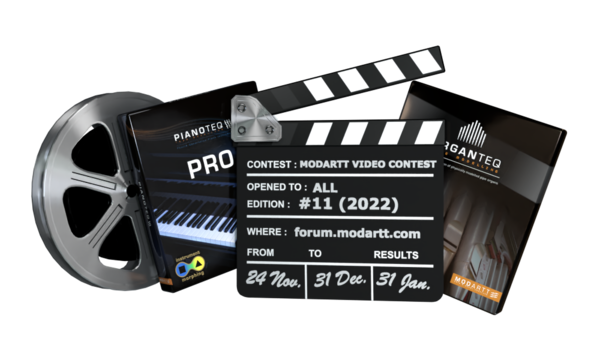https://youtu.be/zVZKUhSUaIk
The film opens up with a glimpse of our tiny dancer warming up, then dissolves to the primary setting with piano and performer.
Featured prominently in this scene is Pianoteq on a large iPad Pro. Is Pianoteq for iOS finally here?
This is Pianoteq running on a Raspberry Pi 400, hooked up to a Kawai Novus NV10 with Millennium III grand piano action. Pianoteq features gloriously on the iPad via VNC, acting both as a piano visualizer and touch controller. This is mere luxury, since Pianoteq can be controlled directly from the Novus via dedicated MIDI control channel.
Although this is not a case of Pianoteq running on an iPad, it is arguably the superior setup for this scenario. The iPad is completely unencumbered with wires or interfaces. Meanwhile, thanks to performance optimizations in Pianoteq, the dedicated Raspberry Pi setup is doing all the heavy lifting, yet completely silent and out of sight.
It's hard not to be drawn to the piano roll powered by Simon Rodriguez's Reactive MIDI Visualizer. Remarkably, MIDI Visualizer is completely free, open source on GitHub, and features a no-nonsense yet powerful configuration interface. MIDI Visualizer also has alpha channel support, which can be used to create an augmented reality piano roll effect for a nice variation on the typical Rousseau and Kassia synthesia videos.
Bravo et merci à Simon.
The piano responds wonderfully, with superb playability on the grand action, and fabulous sound experienced via the Novus. The integrated woofer brings the bass to life. Pianoteq effortlessly models an Ant. Petrof while capturing the performance.
The next reveal is that the piano is not actually in equal temperament, but tuned to Kirnberger III. This is a risky choice on the part of the performer, though perhaps, the stakes are not so high. Sarah McLachlan famously recorded Last Dance on a random out-of-tune upright piano per the legendary Pierre Marchard, but here, the virtual piano has been very deliberately configured with a historical tuning employing technology that did not exist in 1997.
How easy would it be for your everyday pianist to tune an Ant. Petrof 275 acoustic grand to a historical temperament? It would be neither fun nor practical to tune an acoustic grand back and forth between different tunings. This is where Pianoteq shines, yet again.
Let's leave the technical praise aside and allow for some musical storytelling.
Our poor dancer collapses. She gets up gingerly and resumes a gentle dance. That was almost the end of her story.
Throughout the piece, the performer has been pedaling mercilessly and the virtual piano strings have been resonating, painting a rich musical tapestry. For a brief moment of Zen, that pedal is released, while the dancer reassesses.
Her life is meaningless without dance.
We take a moment to enjoy the deep bass of the Ant. Petrof and crystalline clarity of the treble. This even inspires our tiny dancer to improvise a few steps that were not quite part of the original choreography.
The ballerina grows bolder. She outdoes herself in what turns out to be her last hurrah. Her heart gives, she collapses, and never rises again.
She had always loved flowers.
End credits are shown. The performer reaches out and deliberately halts the piano simulation.
I had originally created a v1 video with the intention of entering it in the Pianoteq Video Contest 2022. V1 was disqualified by virtue of already being published and Modartt later broke the news that the contest was being delayed for Pianoteq 8. So I painstakingly remade this version with a reactive visualizer for an augmented reality piano roll effect and rebased everything from Pianoteq 7.5.4 to Pianoteq 8!
